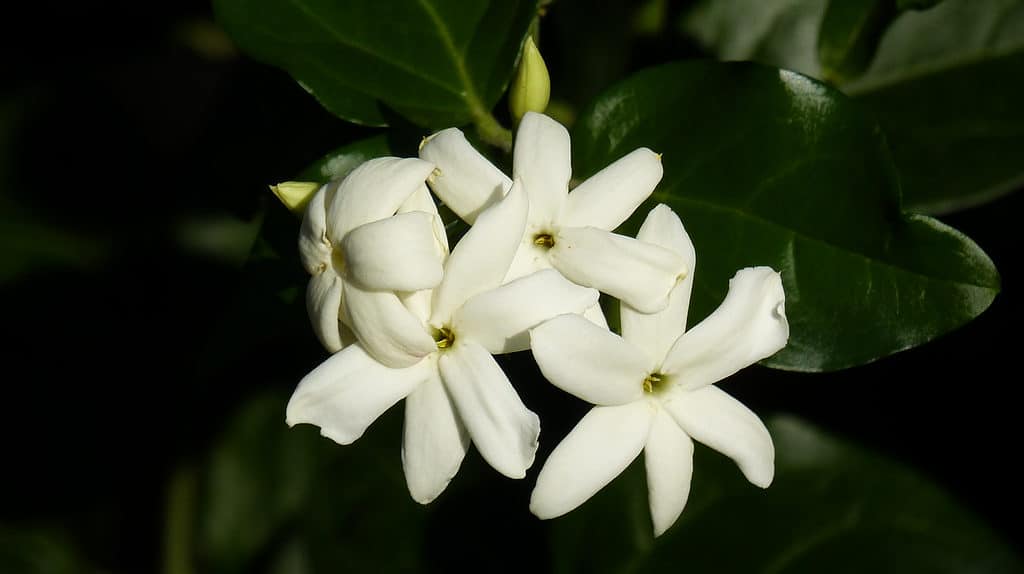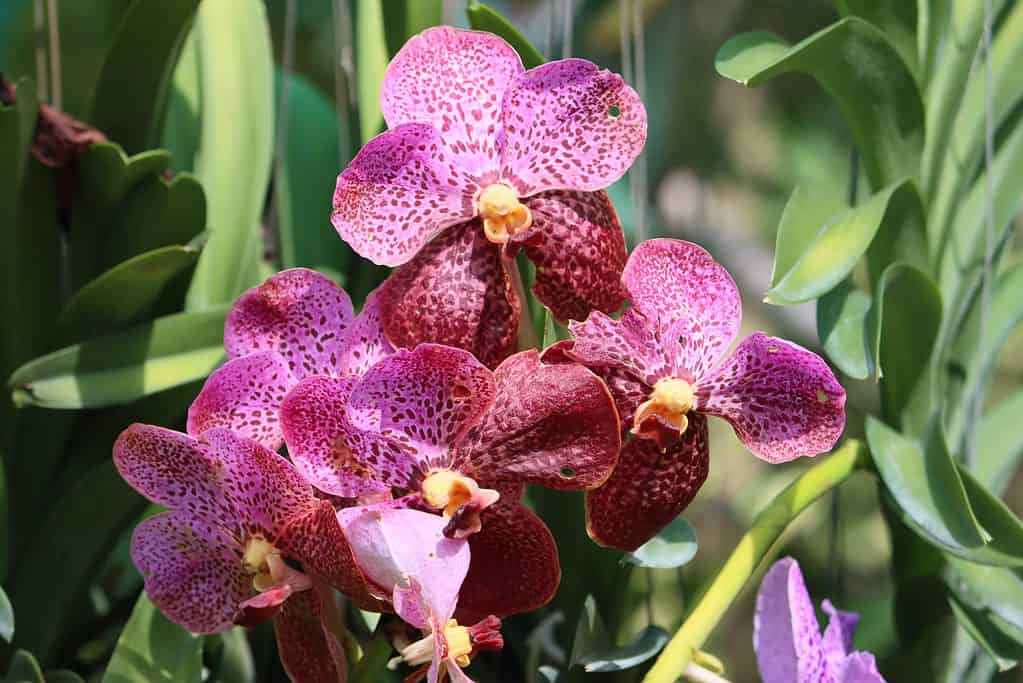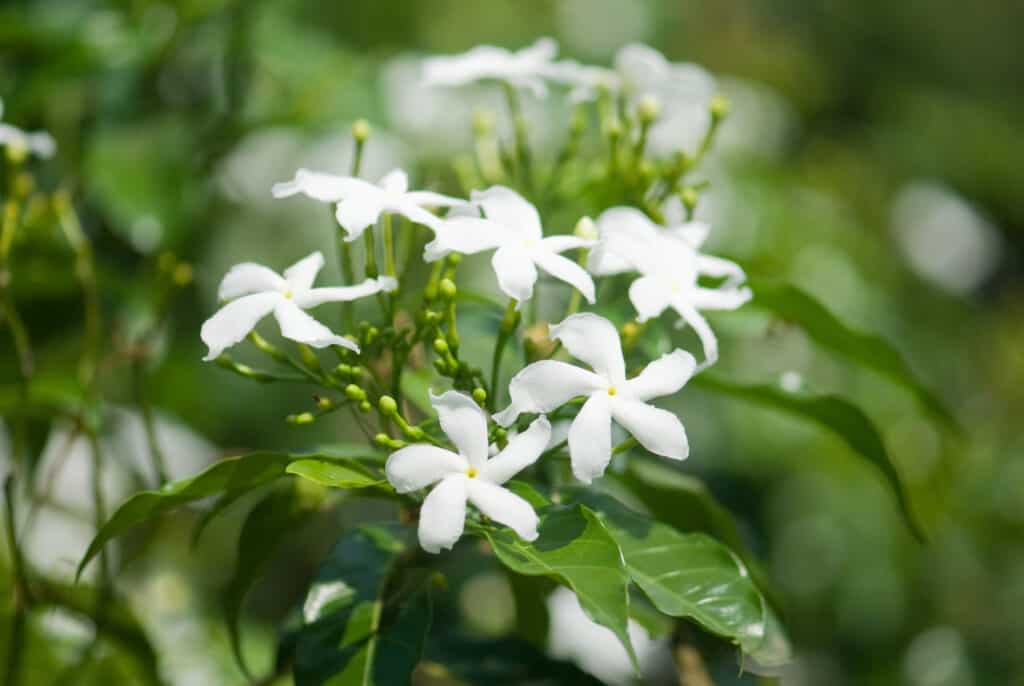Let’s discover the national flower of the Philippines: the Sampaguita. It’s a beautifully scented type of jasmine that grows across the Philippine islands, spreading its fragrance far and wide.
There’s no arguing the Philippines’ national flower is a total knockout. Here’s why and how you can grow your own.
What Is the National Flower of the Philippines?
The Sampaguita is the national flower of the Philippines. Its scientific name is Jasmine sambac, but it’s commonly known as Asian jasmine, Arabian jasmine, sacred jasmine, or Asiatic jasmine. Although it has many names, it’s the only official national flower of the Philippines.
Sampaguita sits in the Oleaceae family, and although it’s the national flower of the Philippines, it’s not a native. Scientists aren’t sure exactly where sambac jasmine originates because it’s been traded and cultivated for thousands of years. Our ancestors loved it just as much as the Filipinos do!
Sampaguita is thought to originate from India. In the 1500s, Arabian and Persian travelers took it with them across the globe. Experts think Sampaguita may have arrived in the Philippines in the 17th century, in high style across the Himalayas!

Jasmine is native to a small region in the eastern Himalayas in Bhutan and neighboring Bangladesh, India, and Pakistan.
©guentermanaus/Shutterstock.com
Where Are the Philippines?
Let’s take a quick look at the Philippines’ geography and history because this will help us understand why the Sampaguita was chosen as their national flower.
The Republic of the Philippines is an archipelagic country comprising 7,641 islands. All the islands are situated in Southeast Asia in the Pacific Ocean and are surrounded by the South China Sea, the Philippine Sea, and the Celebes Sea.
The archipelago is divided into three governing sections: the northernmost is Luzon, the middle section is Visayas, and the southernmost area is Mindanao. The Filipino capital is Manila, and 109 million people live across its islands. Sampaguita jasmine grows throughout the archipelagoes.
The Philippines is an unusual country made up of thousands of islands, so it’s no surprise that many different ethnicities and religions inhabit it.
The earliest inhabitants of the Philippines included the Andamanese, the Semang, and the Maniq. They were joined by the Austronesians from areas including Polynesia, New Guinea, Taiwan, and Madagascar.
In 1543, the Spanish explorer Ruy Lopez de Villalobos named the archipelago after King Philip II of Spain, beginning 300 years of Spanish colonization. Following this, America established control until World War 2, and in 1946, the Philippines finally gained independence.
This tumultuous history explains why modern Filipinos may prefer the endemic waling-waling flower over the non-native Sampaguita as their national symbol. More on that below.

The Philippines is off the coast of Vietnam.
©Hyotographics/Shutterstock.com
Why Is the Sampaguita the National Flower of the Philippines?
Jasmine Sampaguita was chosen as the national flower of the Philippines when the United States controlled the area. In February 1934, the American Governor-General Frank Murphy chose it to represent the people because it is a Filipino symbol of purity, simplicity, humility, and strength, and it is also the subject of many Filipino legends.
This shrub is super tough, as we can see from the ease with which it has colonized so many landmasses, but it’s also fragrant and beautiful.
Sampaguita is a Spanish term sumpa kita for “I promise you”. One of the most enduring legends is that it grew on the grave of a lover who was waiting for their love to fulfill a promise. Another Filipino story tells that despite the short-lived nature of Sampaguita blooms, they still fill the world with good. They are an example for everyone to live by.
Since the 17th century, Sampaguita has been grown in Filipino royal gardens and frequently used in religious ceremonies. For example, Sampaguita-filled candles and incense are used to purify buildings and bar any type of evil from entering.
Is Waling-Waling the National Flower of the Philippines?
In 2013, the Philippines’ Senate passed a bill to make the waling-waling orchid (Vanda sanderiana) a national flower along the Sampaguita, but the President vetoed it.
Senator Loren Legarda pushed for waling-waling as a second national flower to update the Philippines’ national floral symbol now that the country is independent. Remember, the American governor-general chose sampaguita in 1934 before the country’s independence in 1946.
Waling-waling is endemic to the Philippines and critically endangered. Although giving this flower the national flower status was believed to help protect it, the President stated other means of preservation were available.
This leaves Sampaguita as the Philippines’ only national flower, at least officially.
Are you now thinking about the endemic waling-waling? Good call; it’s a stunning plant called ‘Queen of Phillippine Flowers.’ It’s so stunning the indigenous Bagobo people worship it as a Diwata (a fairy).
Waling-waling is an epiphyte orchid that grows on trees. It has long-stemmed pink and rose-pink flowers that measure 4-6 inches across and a base of thick, green, fleshy leaves.

The waling-waling flower.
©Kolinchev Andrii/Shutterstock.com
What Does a Sampaguita Flower Look Like?
We can’t discover the national flower of the Philippines, the Sampaguita, without taking a good look at its flowers, scent, leaves, and growing habits. Here are all the facts about Jasmine Sambac.
Sampaguita is an evergreen shrub that can grow into a bush, so it’s not the same as common climbing jasmine. Despite this difference, the fragrance is very similar. It’s sweet, almost honey-like, and very powerful. It wafts through parks, gardens, and temples, especially during the evening.
Sampaguita can grow to just under 10 feet in height. It has green, ovate leaves in groups of three, and its sweetly scented flowers are white. They grow in clusters at branch ends and are slightly smaller than other jasmine blooms.
Sampaguita jasmine is a night bloomer. Its petals open during the evening to primarily attract moths, but bees and butterflies also manage to prise open the buds in the daytime.
Another big difference between sampaguita and other jasmine species is its tropical nature. The Philippines has a warm, humid climate that encourages year-round growth, but it’s possible to grow it in warm US states, too – more on that later.
Does Sampaguita Smell Sweet?
Yes, Sampaguita smells sweet. It’s a type of jasmine with a refreshing, sweet scent, similar to honey or the midnight jasmine species. It’s a very heady scent that pollinators love.
Are Jasmine and Sampaguita the Same?
Sampaguita is a species of jasmine, so although they are not the same, they are closely related. Sampaguita is a tropical plant with slightly smaller flowers and can grow as a bush.

Jasmine typically has small, star-shaped flowers.
©Tukaram.Karve/Shutterstock.com
How to Grow Sampaguita
Sampaguita will grow in USDA zones 8 and above. It can cope with humidity but not frost. If your zone gets an occasional frost, it’s best to grow Sampaguita jasmine in a container so it can be moved somewhere frost-free if low temperatures are forecast.
In cooler zones, sampaguita is an excellent conservatory plant or greenhouse plant.
Here’s how to grow it:
- Choose a sunny spot
- Work lots of organic matter into the soil. Sampaguitas like rich soil!
- If you want to grow a vine, plant it against a fence or trellis, but tilt the plant against the fence so its roots are at least 12 inches away from the footings.
- Tie in new growth as it emerges.
- Water it frequently until you see new growth, then several times a week to encourage flowering. If the plant is too dry, it won’t flower.
- Deadhead flowers as they fade to encourage more fresh blooms.
- If you’re growing sampaguita in a container, water and fertilize it regularly because they are hungry plants.
How to Grow Sampaguita from Cuttings
Jasmine plants are easy to root. If you spot one at a friend’s house, ask for a few stems, and you can have your own sampaguitas for free.
Sampaguita cuttings are easy to take and grow. Simply cut 8-10-inch long stems and push them into a pot of damp, gritty compost. Be sure to push the cut end into the soil! It’s very easy to get mixed up.
Strip the bottom half of the leaves and remove any flowers before pushing them into the soil. Your cuttings need all their energy to grow new roots.
Keep the container compost moist and somewhere warm to stimulate healthy, fast new growth.
The cuttings will begin to root after several weeks. As they grow, move them into individual pots. There’s no need to cover the stems with a plastic bag.
The photo featured at the top of this post is © guentermanaus/Shutterstock.com
Thank you for reading! Have some feedback for us? Contact the AZ Animals editorial team.






